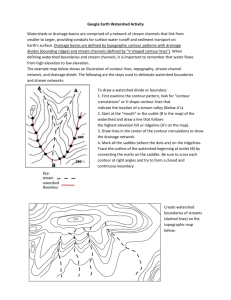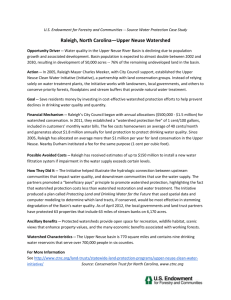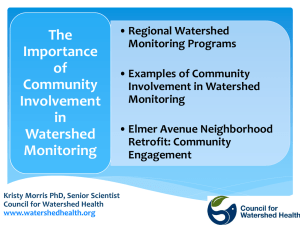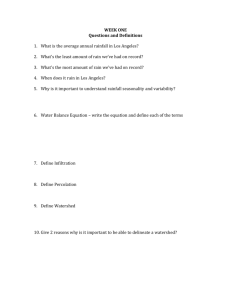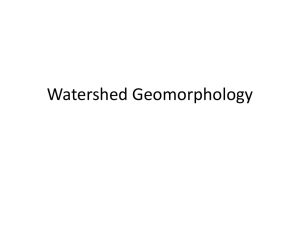DOC - Commonwealth Association for Education Administrator
advertisement
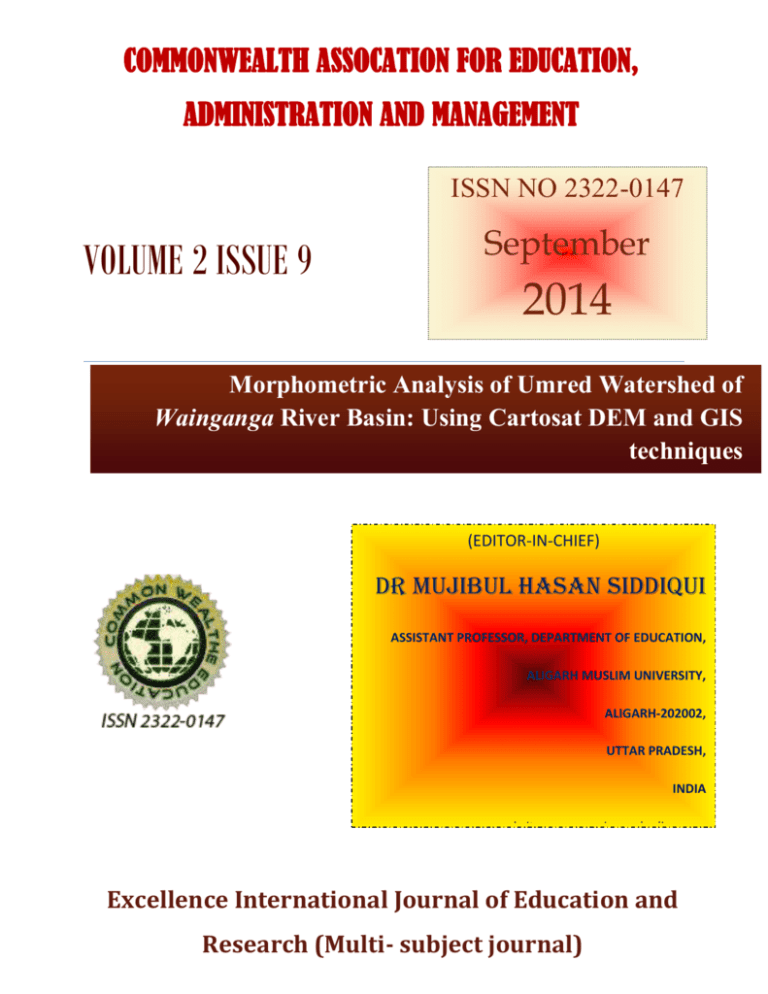
COMMONWEALTH ASSOCATION FOR EDUCATION, ADMINISTRATION AND MANAGEMENT ISSN NO 2322-0147 VOLUME 2 ISSUE 9 September 2014 Morphometric Analysis of Umred Watershed of Wainganga River Basin: Using Cartosat DEM and GIS techniques (EDITOR-IN-CHIEF) DR MUJIBUL HASAN SIDDIQUI ASSISTANT PROFESSOR, DEPARTMENT OF EDUCATION, ALIGARH MUSLIM UNIVERSITY, ALIGARH-202002, UTTAR PRADESH, INDIA website: www.ocwjournalonline.com Excellence International Journal of Education and Research (Multi- subject journal) Excellence International Journal Of Education And Research VOLUME 2 ISSUE 9 ISSN 2322-0147 Morphometric Analysis of Umred Watershed of Wainganga River Basin: Using Cartosat DEM and GIS techniques. By Mohammad Suhail Research Scholar Department of West Asian Studies Aligarh Muslim University Aligarh. India. Email- Id: ms13153@gmail.com. Abstract This paper is an attempt to understand watershed morphometry with the integration of Cartosat (DEM) of ISRO’s Stereoscope panchromatic mission (2.5 meter spatial resolution), LISS-III Optical data with standard FCC band combination and GIS technique. Moreover, such morphometric analysis having imperative space in any hydrological investigation and can play inevitable role in the development and management of drainage basin and water resources. A critical evaluation and assessment of morphometric parameters such as linear, aerial and relief, overall 27 parameters have been selected for this study which includes Stream order, Bifurcation ratio, Stream length, Cumulative Stream length, Stream frequency, Circulatory Ratio, Slope, Aspect, Relief ratio, Elongation Ratio, Drainage Density, Perimeter, Texture Ratio etc. for Umred watershed of Wainganga river basin in Nagpur district of Maharashtra, India. Further, the spatial characteristics and the analysis of these variables are taken into consideration with the help of conventional tools as well as emerging geo-spatial techniques. Digital image processing and edge enhancement process enables in this paper for extraction of substantial information and interpretation of LISS-III data facilitated with the help of ARCGIS v. 9.3 and Erdas Imagine v. 9.2 softwares. Finding shows that dendrite drainage pattern with low density in watershed pertaining to permeable landscape and small runoff potential. Lesser bifurcation ratio has been noticed which indicates lack of structural control on the drainage pattern. Line of best fit and 2nd order polynomial coefficient also employ for establishment of logarithms of streams length and order relationship. Finally, this study would help to understand watershed quantitive morphometry and its utilization for assessment and management of the resources on a sustainable basis. Keywords: Cartosat, DEM, Remote Sensing and GIS, Watershed, Morphometric Parameters. Excellence International Journal Of Education And Research (Multi-subject journal) Page 255 Excellence International Journal Of Education And Research VOLUME 2 ISSUE 9 ISSN 2322-0147 Introduction: Watershed is a natural hydrological entity that drains streams and run-off to a common outlet such as the outflow of a reservoir, mouth of a bay, or any point along a stream or channel. It may consider as the basic unit of the water supply which evolves over a period of time. Ridges and hills that disintegrate two watersheds are known as drainage divider. But fortunately, the word watershed is sometimes used interchangeably use with drainage basin or catchment. The size of a watershed can vary from fraction of hectares to thousands of square kilometers. On the basis of area, watersheds can be classified into micro watershed (0 to 10 ha), small watershed (10 to 40 ha), mini watershed (40 to 200 ha), sub watershed (200 to 400 ha), macro watershed (400 to 1000 ha), river basin (above 1000 ha) (Sharmah, et, al. 2012). Question of Watersheds management are become very pertinent in present scene because it provide seasonal flow of water to domestic, industrial and agricultural water use. Rapid growth in population and industrialization are leading to serious daunting of water resources. The factsheet focuses on water pollution due to human activities such as by lead, mercury, cyanide; nitrates, radioactivity and pesticides are the main threat to human health (Birley, MH, 1995, WHO (IPCS), 2000). On the other hand, morphometry deals with the shape or geometry of any natural formbe it plant, animal or relief feature (Strahler, 1969). Often, morphometry refer as the mathematical measurement, analysis and description of earth’s surface with respect to its shape, dimensions and relief. Moreover, morphometric analysis of watershed requires measurement of linear features, gradient of channel network and contributing ground slopes of drainage basin (Lobeck, 1939; Dury, 1952; Clark, 1958). Convectional study of watershed morphometry based on qualitative as well as qualitative approach includes Horton (1945), Miller (1953), Strahler (1964), Morisawa (1959) etc. While, with the advancement of satellite technology, effective analysis of morphometric parameters such as linear and aerial, the modern approach of remote sensing and geographic information system (GIS) had been a common platform among the researcher. (Srivastava et al., 1995; Srivastava, 1997; Nag, 1998; Agarwal 1998; Biswas et al., 1999; Vittala et al., 2004; Reddy et al., 2004; Nag and Lahiri 2011; Sharmah, et, al. 2012). Such morphometric analysis having imperative space in any hydrological investigation and can play inevitable role in the development and management of drainage basin and water resources. A critical evaluation and assessment of morphometric parameters such as linear and Excellence International Journal Of Education And Research (Multi-subject journal) Page 256 Excellence International Journal Of Education And Research VOLUME 2 ISSUE 9 ISSN 2322-0147 aerial parameters have been selected for this study which includes Stream order, Bifurcation ratio, Stream length, Stream frequency, Sinuosity factor, Circulatory Ratio, Elongation Ratio, Drainage Density, etc. The main purpose of this study are to generate stream properties and hydrological behavior from the measurement of various morphometric attributes which will bestow to forecast the watershed discharge, drainage basin characteristics and simulation. Assortment of hydrological events can be explore and evaluate by the analysis of morphometric variables. For instances, mean annual flood is generally correlated with drainage area and drainage density (Nouh, 1987). Present study will also be helpful for future work enhancement on watershed management level into various arenas as Soil and land management, Water management, Crop management, afforestation, energy management, community management and so on. Study area: Geologically, the study area comprises of Precambrian rocks to recent alluvium with the thick succession of Upper Paleozoic and Mesozoic rocks deposits. Tectonically, watershed is a part of NW-SE elongated Graben Valley of Godavari River. Sedimentary rocks are grouped into Gondwana sequence that is known for its rich coal deposits. An elliptical shape watershed lies in Umred Taluka of Nagpur district (Figure: 1). Geographically, watershed is spread over between latitude 20˚51′48″ N to 20˚58′13″ N and longitude 79˚07′83″ E to 79˚18′04″ E with an area of 131.915 sq. km. Many of villages and Nagpur city along the watershed are situated and NH-7 bordering it at West, Nagpur City towards North, Muniya Reserved Forest to Southern and Wainganga River at East. Further, watershed falls in Survey of India (1:50000) toposheets no. 55 L/1, 55 H/13, 55 K/4. Moreover, It compasses semi arid climate, winter season endure from October to February while, December and January are severely cold. The average day temperature is about 270C and reaches at 140C in night but sometimes it can descend by 50C. Temperature increase starts from the month of March and reach hottest in May with average at 400C to 470C. Study area mainly experiences rainfall from south-west monsoon. It rains from June to Excellence International Journal Of Education And Research (Multi-subject journal) Page 257 Excellence International Journal Of Education And Research VOLUME 2 ISSUE 9 ISSN 2322-0147 September with average rainfall of 800-900 mm annually. The heaviest rainfall in 24 hours recorded at Umred station was 330.20 mm. (13.00 inches) August 14, 1953 Figure: 1 Study area Location. It also marks gravelly clay loam soil with severe erosion and low land capability with some amount of fine sand and silt. Moreover, soil having medium porosity and higher bulk density in the watershed region. In the watershed area land use / land cover having more than 60 percent of the land area in the agricultural land. Database and methodology: Excellence International Journal Of Education And Research (Multi-subject journal) Page 258 Excellence International Journal Of Education And Research VOLUME 2 ISSUE 9 ISSN 2322-0147 To carry out the study and to analyze morphometric parameters remote sensing data, other ancillary data, GIS and image processing software (Erdas Imagine v. 9.2, Arc GIS v. 9.3 and ILWIS v. 3.4), are used in an appropriate manner. The specifications of data used are tabulated in the table 1. Moreover, methodology includes a systematic approach towards morphometric parameters investigation of Umred basin watershed. First of all, toposheets are geo-referenced with the help of Erdas Imagine software to the projection UTM, spheroid WGS84, datum WGS-84 and zone 44 with less than half pixel RMS error. Then, mosaic process had done for all toposheets for making digitization to demarcate watershed boundary layer. Table: 1 Acquired satellite and other data for the present study. Satellite/Sensor Tile name Resourcesat-1/ LISS-III F44T05 100 57 Resourcesat-1/ LISS-III F44T01 100 57 Cartosat1/PAN(2.5m) Stereo Data Path F44T Upper right: X = 80E, Y = 21N Lower right: X = 80E, Y = 20N Row Satellite Data Acquisition Acquired date Date via FTP 19-Oct-08 2/1/2012 19-Oct-08 2/1/2012 20/08/2011 Upper left: X = 79E, Y = 21N Lower left: X = 79E, Y = 20N 2/1/2012 Characteristics Ortho-Rectified, Number of Bands: 4 (VNIR and SWIR) Spatial Resolution: 23.5 m. Swath: 141 km. Spectral Resolution: 7 Bit, Revisit period 24 days. Ortho-Rectified, Number of Bands: 4 (VNIR and SWIR) spatial resolution: 23.5 m. Swath: 141 km. Spectral Resolution: 7 Bit, Revisit period 24 days. Ortho-Rectified, Number of Bands: 1 PAN (500-850 nm) Spatial Resolution: 2.5 m (1arc sec), Swath: 29.42 km. Spectral Resolution: 10 Bit, Revisit period 5 days. Other Data Source/Sources Topo-Sheets Survey of India: No. 55 L/1, 55 H/13, 55 K/4 at 1:50000 This layer is utilized for creating subset of Cartosat DEM and LISS-III derived image data. The slope, aspect, drainage network map are generated using special analysis tools in Arc GIS software to establish a spatial database for deciding watershed morphometric parameters. Edge enhancement and filtering algorithms are applied on LISS-III data. Integration of these layers of LISS-III data and Cartosat DEM are derived with the help of Erdas Imagine for accuracy check. Excellence International Journal Of Education And Research (Multi-subject journal) Page 259 Excellence International Journal Of Education And Research VOLUME 2 ISSUE 9 ISSN 2322-0147 Further, analysis of morphometry has to be divided into three sections as linear, aerial, and relief inquisition. Among linear and aerial morphometric parameters that were determined by utilizing the digital special database are stream orders (Strahler), stream length, bifurcation ratio, basin area, basin length, drainage density, form factor, circularity, elongation ratio, perimeter etc. Relief factor includes channel gradient, watershed slope, aspect ratio, relief ratio, ruggedness number and so on. Result and Discussion: The investigation of morphometric characteristic of Umred basin watershed had been gone through a systematic approach towards quantization. Different parameters had been studied but in simple understanding it is divided into three parts namely linear, aerial and relief. 1. Linear aspect of studied watershed: In order to analyze linear aspect of watershed the first step is to determine the stream order classification with the help of Cartosat DEM. Channel segments has been categorize according Strahler (1964) hierarchical approach. Table: 2 linear parameters of watershed. Tot_Seg Cum_Strm Bifur_ Strm_m Cum_M_ Log Log _Lngth Seg_Lngth Rt _Ln Strm_Ln Nu Lu Lu (Km) (Km) (Rb) (Lu') (Km) 1 94 72.77 72.77 0.77 0.77 1.97 1.86 2 39 32.54 105.31 2.24 0.83 1.61 1.59 1.51 3 30 19.12 124.42 1.70 0.64 2.25 1.48 1.28 4 15 9.23 133.65 2.07 0.62 2.86 1.18 0.97 Mean 44.50 33.41 --2.00 Strm_Ord: Stream Order, N_Seg: No. of Segments, Tot_Seg_Lngth Lu: Total Segment Length, Cum_Strm Seg_Lngth: Cumulative Stream Segment Length, Bifur_Rt: Bifurcation Ratio, Strm_m_Ln: Stream mean length, M_Bifur_Rt: Mean Bifurcation Ratio, Cum_M_Strm_Ln: Cumulative Mean Stream Length. Strm_ Ord(u) N_Seg (Nu) It is consider that ordering of stream follows a proportional relation with the size of watershed and channel dimension to the stream discharge. Water flows from the head towards the mouth in a river system, streams gradually increase their width and depth with increasing Excellence International Journal Of Education And Research (Multi-subject journal) Page 260 Excellence International Journal Of Education And Research VOLUME 2 ISSUE 9 ISSN 2322-0147 volume of discharge. Watershed represents 4th order and relatively less discharge due to homogeneity in texture and lack of structure control (all linear results are summarized in table: 2 and figure: 2). Dendrite drainage pattern also observed in the study area with a parallel drainage channel that joined the main channel at approximately same angle. It has suggested that the study area has gentle and uniform slope. Moreover, to analyze surface runoff characteristic of watershed basin, stream length is another significant hydrological feature. Short length stream are represents the area of fine texture and steep slope whereas long length vice versa. Present study considers both length of streams and cumulative length for the watershed. Length measurement has been taken through GIS technique in special analyst tool of Arc GIS software. Figure: 2 (A and B) Cartosat derived digital elevation model and drainage order system. For understanding geometry and lithological control of present watershed classical bifurcation ratio (Strahler, 1964; Horton, 1945) has been utilized. Estimated ratio represents elongation of watershed and lower value of bifurcation as comparative to typical range of 3 to 5. Watershed does not have any impact of structural disturbances. The second order polynomial regression line also had been fit between stream order as independent variable and stream number and length dependant variable for verification Horton’s Excellence International Journal Of Education And Research (Multi-subject journal) Page 261 Excellence International Journal Of Education And Research VOLUME 2 ISSUE 9 ISSN 2322-0147 (1945) principle of stream order. It is states that the numbers of stream segments of each order follow an inverse geometric relationship with small deviation from a straight line (Figure: 3). Figure: 3 Regression and 2nd order polynomial line of stream order as independent variable with respect to algorithm stream number and order dependently. 2 y = 0.0203x2 - 0.3518x + 2.2819 y = -0.2505x + 2.1806 R² = 0.9682 R² = 0.9632 Log Nu 2 y = 0.0083x2 - 0.3337x + 2.1772 R² = 0.9952 Log Lu 1.8 1.6 Log of Stream Length (Lu) Log of Stream Number (Nu) 2.5 1.4 1.5 y = -0.2921x + 2.1356 R² = 0.9945 1.2 1 1 0.8 0.6 0.5 0.4 0.2 0 1 2 3 4 Stream Order (u) 0 1 2 3 4 Stream order (u) According to that the present study area had gone behind similar stream order characteristics. Prediction also put together on about stream order rationale. Regression coefficients are positive with respective to both about stream length and orders. It is indication of homogeneous rock material and low relief feature and also elongated shape but rock material is a subject to weathering and mass wasting. Weathering and mass wasting needs a separate study, so the discussion about it ignored in present context. In general, finding of linear arena of present watershed shows that region has occupied by the low relief feature and shifting toward base level. 2. Aerial parameterization of studied watershed: Illustrations are made on parameterization of aerial behavior of watershed to investigate basin shape and dimensions. This section is devoted to various quantitative variables which are summarized in table 4. Basin area and perimeter of watershed are the two most significant Excellence International Journal Of Education And Research (Multi-subject journal) Page 262 Excellence International Journal Of Education And Research VOLUME 2 ISSUE 9 ISSN 2322-0147 variables which are 131.915 sq. Km. and 20.788 Km. respectively. Studies of basin morphometric analysis (Chorley, et. al, 1957; Singh and Srivastava, 1974) establish pertinent hydrological relationship between magnitude of peak and mean runoff to storm hydrograph. Further, the size of storm and maximum flood discharge per unit had significant inverse relationship. Table: 4 Aerial parameters of watershed. Basin Area sq. km. Length of Basin (Lb) Km. Stream frequency Texture Ratio Basin Perimeter (P) Km. Circularity Ratio (Rc) Shape Factor ratio Drainage Density Form Factor (Rf) Elongation Ratio (Re) 131.915 20.7885 1.349 1.566 60.0385 0.45988 3.2760 1.01315 0.30524 0.62342 Stream frequency (Hortan, 1932) and texture (Schumm, 1965) ratios are 1.35 and 1.57 respectively. It shows that low percolation into groundwater adjacent to shear zone whereas texture ration indicate coarse size rock particles. In addition to this, it is control by underlying lithology, infiltration capacity and relief aspect ratio. Dimension of watershed is near to elongated because of low form factor as 0.31 but shape factor approving it ellipsoid. It also imply that the watershed have a cajole peak of flow for longer duration. Flood like phenomenon will be effortless to manage than of the high form factor watershed. Moreover, circularity ratio (Muller, 1953) found as 0.45 Km-1 in study area, which is an indication of elongated and permeable geological conditions with low runoff. Again elongation ratio as 0.62 Km-1 and drainage density as 1.01 Km-1 shows that low relief and base level condition. Drainage density (Hortan, 1945 and Strahler, 1958) is a pertinent tool for quantitative expression of dissected analysis of morphogenesis of landforms. Low drainage density of study area is due to negligible soil and vegetation cover, buried Excellence International Journal Of Education And Research (Multi-subject journal) Page 263 Excellence International Journal Of Education And Research VOLUME 2 ISSUE 9 ISSN 2322-0147 pediment, younger alluvium, denudational hill and flat top of plateau which is also observe in standard FCC of LISS-III optical data. 3. Relief morphology of study area: Relief variable includes aspect, slope, channel gradient, relief ratio, ruggedness number and relative relief factor in present paper which are summarize in table 5. North aspect ratio represents around 57 percent of relief whereas south aspect around 43 percent as a result of direction of major fracture and fault lines (figure: 4) and these fractures and fault lines are running along the N-S direction (Brown, et.al, 1989). However, aspect ratio is an important hydrological parameter due to runoff induction and infiltration of water into capillary. Table: 5 Relief parameters of watershed. Relief Ratio (Rh = H/Lb) Ruggedness Number (Rn = D*H) Relative Relief Ratio Channel Gradient Aspect Ratio (North) Aspect Ratio (South) 0.005 0.103 0.170 1.172 56.580 43.420 Moreover, inclination of terrain depends on several factors as climate, geology, tectonic action, relief feature and so on. General behavior of inclination of terrain has been analyzed through area under covered by the slope (table: 6 and figure: 4). Further, Around 92 percent of total area is fall within 1-5 percent inclination in the present study area. Channel gradient as 1.17 is very low and indicate that drainage density has the little impact on denudational agents. Surface runoff will not slickly remove from watershed area and hence drift the region into flooding and erosion. Increase in discharge enables sediment load toward transportation capacity but it is still subject to changing slope. Sediment characteristic and rock wasting are the result of relief ratio (Schumm, 1956). Excellence International Journal Of Education And Research (Multi-subject journal) Page 264 Excellence International Journal Of Education And Research VOLUME 2 ISSUE 9 ISSN 2322-0147 Table: 6 Slope statistics of the study area. Sl. no. Slope Area in sq km Area in (%) 1 2 3 4 5 6 1-3% 3-5% 5-10% 10-15% 15-35% 35-50% 71.52 49.88 3.56 1.66 4.18 1.11 54.21879 37.81366 2.69881 1.258434 3.168827 0.841483 It has been observed that low relief value as 0.005 is due to resistant basement rock and associated slope degree. Large area covered by squat degree of slope with lesser relief suggested trivial amount of sediment loose per unit area. Figure: 4 Aspect and Slope map of study area. In addition to that Ruggedness number (Strahler, 1968) suggests gentle slope with low relief. It means that present study area is not as much of prone to soil erosion and inherent structural control over a period of time. Excellence International Journal Of Education And Research (Multi-subject journal) Page 265 Excellence International Journal Of Education And Research VOLUME 2 ISSUE 9 ISSN 2322-0147 Conclusion: Remote Sensing and GIS techniques are immense imperatives as significant tool in hydrological and morphological study of watersheds and river basin evaluation. New vistas of digitally derived satellite data with fine spatial resolution are providing precise geometry and dimensionality for watershed analysis. The prospect of quickly coalesce of spatial data of different layers in GIS environment has leading towards investigation of hydrological applications and simulation. Present study is the output of Cartosat derived digital elevation model with the integration of some spatial information. Different layers have been generated through various mathematical algorithms in GIS environment. Algorithms include flow direction, flow accumulation, slope, aspect, drainage network and so on. Result shows that watershed is a 4th order stream network with dendrite type of drainage of low density. It has homogeneity in texture with coarse to fine grained rock granule and lack of structural control due to resistance of rock material. Study area is flat top with low slope and relief which verified channel gradient law of positive relationship with relief ratio (Singh, 1994). It is also observed that around 92 percent of total area is less than 1 to 5 degree of inclination. Acknowledgment: I would like to express my deep sense of gratitude to National Remote Sensing Centre, Hyderabad for providing me satellite data for present outcome. I am also indebted to training team of NRSC, especially head of the training division Dr. D. Vijyan, Sr. Scientist, for giving me valuable training and stimulation for understanding the concept of remote sensing. References: Agarwal, CS (1998) Study of drainage pattern through aerial data in Naugarh area of Varanasi district, U.P. J. Indian Soc. Rem. Sens., 26(4): 169-175. Birley, MH (1995) The health impact of development projects, HMSO, UK. Excellence International Journal Of Education And Research (Multi-subject journal) Page 266 Excellence International Journal Of Education And Research VOLUME 2 ISSUE 9 ISSN 2322-0147 Biswas, S Sudhakar, S and Desai, VR (1999) Prioritization of sub watersheds based on morphometric analysis of drainage basin: A remote sensing and GIS approach. J. Indian Soc. Rem. Sens., 27(3): 155–166. Brown, GF Schmidt, DL and Huffan, AC (1989) Geology of the Arabian Peninsula, Shield area of Western Saudi Arabia, USGS Professional paper, 560-A. Chorley, R.J (1972) Spatial Analysis in Geomorphology, Mathuen and Co. Ltd., London. Chorley, R.L (1967) Models in Geomorphology, in R.J. Chorley and P. Haggett (eds.), Models in Geography, London, pp 59-96. Chorley, RJ Malm, DEG and Pogorzelki, HA (1957) A new standard for estimating drainage basin shape. Am. J. Sci., 255: 138–141. Doornkamp, JC Cuchlaine, AMK (1971) Numerical analysis in Geomorphology: An Introduction. Edward Arnold, London, pp. 3-20. Dury, G.H (1952) Methods of Cartographical Analysis in Geomorphological Research, Silver Jubilee Volume, Indian Geographical Society, Madras, pp 136-139. Horton, RE (1932) Drainage basin characteristics. Trans. Am. Geophys. Union., 13: 350–361. Horton, RE (1945) Erosional development of streams and their drainage basins: Hydro-physical approach to quantitative morphology. Bull. Geol. Soc. Am., 56: 275-370. Lobeck, AK (1939). Geomorphology, Mc-Graw Hill, New York. Miller, VC (1953) A quantitative geomorphic study of drainage basin characteristics in the Clinch mountain area. Virginia and Tennessee. Technical report III. Columbia University, Department of Geology, ONR, New York. Morisawa, ME (1959) Relation on morphometric properties to runoff in the Little Mill Creek: Ohio drainage basin. Technical Report XVII, Columbia University, Department of Geology, ONR, New York. Excellence International Journal Of Education And Research (Multi-subject journal) Page 267 Excellence International Journal Of Education And Research VOLUME 2 ISSUE 9 ISSN 2322-0147 Nag SK (1998) Morphometric analysis using remote sensing techniques in the Chaka sub-basin Purulia district, West Bengal.” J. Indian. Soc. Rem. Sens., 26: 69–76. Nag, SK and Lahiri, Anindita (2011). Morphometric analysis of Dwarakeswar watershed, Bankura district, West Bengal, India, using spatial information technology”. International Journal of Water Resources and Environmental Engineering Vol. 3(10), pp. 212-219, 21 October, 2011. ISSN-1991-637 X. http://www.academicjournals.org/IJWREE. Narendra, K and Nageswara, RK (2006) Morphometry of the Mehadrigedda watershed, Visakhapatnam district, Andhra Pradesh using GIS and remote sensing. J. Indian Soc. Rem. Sens., 34: 101–110. Nouh, M (1987) Estimation of design flood in selected basins in Saudi Arabia. Arab J Sci Eng 12: 429-440. Reddy, GP Obi, M Amal, K and Gajbhiye, KS (2004) Drainage morphometry and its influence on landform characteristics in a basaltic terrain, Central India - A remote sensing and GIS approach. Int. J. Appl. Observ. Geoinfo. 6: 1-16. Sarmah, K. et. al. (2012) “Morphometric analysis of a highland micro-watershed in East Khasi Hills District of Meghalaya, India: Using remote sensing and geographic information system (GIS) techniques”. Journal of Geography and Regional Planning Vol. 5(5), pp. 142-150, 4 March, 2012. ISSN 2070-1845. http://www.academicjournals.org/JGRP. Schumm, S.A (1954) The relation of Drainage Basin Relief to Sediment Loss, International Association of Scientific Hydrology, 36, pp 216-219. Schumm, S.A (1956) Evolution of Drainage Systems & Slopes in Badlands at Perth Anboy, New Jersey, Bulletin of the Geological Society of America, 67, pp 597-646. Schumm, S.A (1963) Sinuosity of Alluvial Rivers on the Great Plains, Bulletin of the Geological Society of America, 74, pp 1089-1100. Excellence International Journal Of Education And Research (Multi-subject journal) Page 268 Excellence International Journal Of Education And Research VOLUME 2 ISSUE 9 ISSN 2322-0147 Shrivastava, VK (1997) Study of drainage pattern of Jharia coalfield (Bihar), India, through remote sensing technology. J. Indian Soc. Rem. Sens., 25(1): 41-46. Shrivastava, VK and Mitra, D (1995) Study of drainage pattern of Ranigang Coalfield (Burdwan District) as observed on Landsat-TM/IRS LISS-III Imagery. J. Indian Soc. Rem. Sens., 23(4): 225-235. Singh, S (1996) Geomorphology, Prayag Pustak Bhawan, Allahabad. India. pp.162-63. Singh, S (1998) Physical geography, Prayag Pustak Bhawan, Allahabad. India. Strahler, AN (1957) Quantitative analysis of watershed geomorphology. Trans. Am. Geophys. Union. 38: 913-920. Strahler, AN (1964) Quantitative geomorphology of drainage basin and channel network. In: V.T.Chow (ed.) Handbook of Applied Hydrogeology. McGraw Hill Book Co., New York, pp. 476. Vittaala, S Srinivas, G Gowda, S and Honne, H (2004) Morphometric Analysis of Su-watershed in the Pavagada area of Tumkur district, South India using Remote Sensing and GIS technique. J. Indian Soc. Rem. Sens., 32(4): 351-362. WHO (1990) Public health impact of pesticides used in agriculture, Geneva: World Health Organization, ISBN 92 4 156139 4. WHO (2000) Hazardous chemicals in human and environmental health: a resource book for school, college and university students. Geneva: WHO (IPCS). Excellence International Journal Of Education And Research (Multi-subject journal) Page 269


